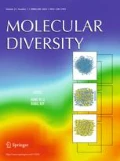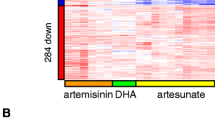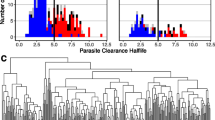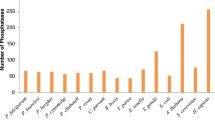Abstract
The Apicomplexa parasite Plasmodium is a major cause of death in developing countries which are less equipped to bring new medicines to the market. Currently available drugs used for treatment of malaria are limited either by inadequate efficacy, toxicity and/or increased resistance. Availability of the genome sequence, microarray data and metabolic profile of Plasmodium parasite offers an opportunity for the identification of stage-specific genes important to the organism’s lifecycle. In this study, microarray data were analysed for differential expression and overlapped onto metabolic pathways to identify differentially regulated pathways essential for transition to successive erythrocytic stages. The results obtained indicate that S-adenosylmethionine decarboxylase/ornithine decarboxylase, a bifunctional enzyme required for polyamine synthesis, is important for the Plasmodium cell growth in the absence of exogenous polyamines. S-adenosylmethionine decarboxylase/ornithine decarboxylase is a valuable target for designing therapeutically useful inhibitors. One such inhibitor, \(\upalpha \)-difluoromethyl ornithine, is currently in use for the treatment of African sleeping sickness caused by Trypanosoma brucei. Structural studies of ornithine decarboxylase along with known inhibitors and their analogues were carried out to screen drug databases for more effective and less toxic compounds.








Similar content being viewed by others
References
WHO (2013) World malaria report 2013. 1–178
Kumar A, Valecha N, Jain T, Dash AP (2007) Burden of malaria in India: retrospective and prospective view. Am J Trop Med Hyg 77:69–78
Tyagi V, Sharma AK, Yadav R, Agrawal OP, Devanathan Sukumaran D, Veer V (2013) Characteristics of the larval breeding sites of Anopheles culicifacies sibling species in Madhya Pradesh, India. Int J Malar Res Rev 1:47–53
Autino B, Corbett Y, Castelli F, Taramelli D (2012) Pathogenesis of malaria in tissues and blood. Mediterr J Hematol Infect Dis 4:e2012061. doi:10.4084/MJHID.2012.061
Le Roch KG, Zhou Y, Blair PL, Grainger M, Moch JK, Haynes JD, De La Vega P, Holder AA, Batalov S, Carucci DJ, Winzeler EA (2003) Discovery of gene function by expression profiling of the malaria parasite life cycle. Science 301:1503–1508. doi:10.1126/science.1087025
Foth BJ, Zhang N, Chaal BK, Sze SK, Preiser PR, Bozdech Z (2011) Quantitative time-courseprofiling of parasite and host cell proteins in the human malaria parasite Plasmodiumfalciparum. Mol Cell Proteomics. doi:10.1074/mcp.M110.006411
Orth JD, Thiele I, Palsson BØ (2010) What is flux balance analysis? Nat Biotechnol 28:245–248. doi:10.1038/nbt.1614
Yeh I, Hanekamp T, Tsoka S, Karp PD, Altman RB (2004) Computational analysis of Plasmodium falciparum metabolism: organizing genomic information to facilitate drug discovery. Genome Res 14:917–924. doi:10.1101/gr.2050304
Fatumo S, Plaimas K, Mallm J-P, Schramm G, Adebiyi E, Oswald M, Eils R, König R (2009) Estimating novel potential drug targets of Plasmodium falciparum by analysing the metabolic network of knock-out strains in silico. Infect Genet Evol 9:351–358. doi:10.1016/j.meegid.2008.01.007
Huthmacher C, Hoppe A, Bulik S, Holzhütter H-G (2010) Antimalarial drug targets in Plasmodium falciparum predicted by stage-specific metabolic network analysis. BMC Syst Biol 4:1–27. doi:10.1186/1752-0509-4-120
Mwakalinga SB, Wang CW, Bengtsson DC, Turner L, Dinko B, Lusingu JP, Arnot DE, Sutherland CJ, Theander TG, Lavstsen T (2012) Expression of a type B RIFIN in Plasmodium falciparum merozoites and gametes. Malar J 11:1–12. doi:10.1186/1475-2875-11-429
Spitzmüller A, Mestres J (2013) Prediction of the P. falciparum target space relevant to malaria drug discovery. PLoS Comput Biol. doi:10.1371/journal.pcbi.1003257
Muregi FW, Ishih A (2010) Next-generation antimalarial drugs: hybrid molecules as a new strategy in drug design. Drug Dev Res 71:20–32. doi:10.1002/ddr.20345
Ritchie ME, Phipson B, Wu D, Hu Y, Law CW, Shi W, Smyth GK (2015) limma powers differential expression analyses for RNA-sequencing and microarray studies. Nucleic Acids Res. doi:10.1093/nar/gkv007
http://www.clcbio.com/products/clc-drug-discovery-workbench/
Karp PD, Paley SM, Krummenacker M, Latendresse M, Dale JM, Lee TJ, Kaipa P, Gilham F, Spaulding A, Popescu L, Altman T, Paulsen I, Keseler IM, Caspi R (2009) Pathway tools version 13.0: integrated software for pathway/genome informatics and systems biology. Brief Bioinform 11:40–79. doi:10.1093/bib/bbp043
Plata G, Hsiao T-L, Olszewski KL, Llinás M, Vitkup D (2010) Reconstruction and flux-balance analysis of the Plasmodium falciparum metabolic network. Mol Syst Biol 6:1–15. doi:10.1038/msb.2010.60
Caspi R, Foerster H, Fulcher CA, Dreher K, Foerster H, Fulcher CA, Holland TA, Keseler IM, Kothari A, Kubo A, Krummenacker M, Latendresse M, Mueller LA, Ong Q, Paley S, Subhraveti P, Weaver DS, Weerasinghe D, Zhang P, Karp PD (2008) The metaCyc database of metabolic12 pathways and enzymes and the BioCyc collection of pathway/genome databases. Nucleic Acids Res. doi:10.1093/nar/gkm900
Ginsburg H, Tilley L (2011) Plasmodium falciparum metabolic pathways (MPMP) project upgraded with a database of subcellular locations of gene products. Trends Parasitol 27:285–286. doi:10.1016/j.pt.2011.03.001
Kanehisa M, Goto S, Furumichi M, Tanabe M, Hirakawa M (2009) Plasmodium falciparum metabolic pathways (MPMP) projectupgraded with a database of subcellular locations of gene products. Trends Parasitol 27:285–286. doi:10.1016/j.pt.2011.03.001
Bahl A (2003) PlasmoDB: the Plasmodium genome resource. A database integrating experimental and computational data. Nucleic Acids Res 31:212–215. doi:10.1093/nar/gkg081
Schneidman-Duhovny D, Dror O, Inbar Y, Nussinov R, Wolfson HJ (2008) PharmaGist: a webserver for ligand-based pharmacophore detection. Nucleic Acids Res 36:223–228. doi:10.1093/nar/gkn187
Koes DR, Camacho CJ (2012) ZINCPharmer: pharmacophore search of the ZINC database.Nucleic Acids Res . doi:10.1093/nar/gks378
Berthold MR, Cebron N, Dill F, Gabriel TR, Kotter T, Thorsten M, Ohl P, Christoph S, Thiel K, Wiswedel B (2007) KNIME: the konstanz information miner. Stud. Classif. Data Anal. Knowl. Organ. (GfKL 2007)
Cheng F, Li W, Zhou Y, Shen J, Wu Z, Liu G, Lee PW, Tang Y (2012) admetSAR: a comprehensive source and free tool for assessment of chemical ADMET properties. J Chem Inf Model 52:3099–3105. doi:10.1021/ci300367a
Krzywinski M, Altman N (2014) Visualizing samples with box plots. Nat Methods 11:119–120. doi:10.1038/nmeth.2813
Mustacich D, Powis G (2000) Thioredoxin reductase. Biochem J 346:1–8
Wang P, Wang Q, Yang Y, Coward JK, Nzila A, Sims PFG, Hyde JE (2010) Characterisation of the bifunctional dihydrofolate synthase-folylpolyglutamate synthase from Plasmodium falciparum; a potential novel target for antimalarial antifolate inhibition. Mol Biochem Parasitol 172:41–51. doi:10.1016/j.molbiopara.2010.03.012
Dong CK, Patel V, Yang JC, Dvorin JD, Duraisingh MT, Clardy J, Wirth DF (2009) Type II NADH dehydrogenase of the respiratory chain of Plasmodium falciparum and its inhibitors. Bioorg Med Chem Lett 19:972–975. doi:10.1016/j.bmcl.2008.11.071
Van Brummelen AC, Olszewski KL, Wilinski D, Llinás M, Louw AI, Birkholtz L-M (2009) Co-inhibition of Plasmodium falciparum \(S\)-adenosylmethionine decarboxylase/ornithine decarboxylase reveals perturbation-specific compensatory mechanisms by transcriptome, proteome, and metabolome analyses. J Biol Chem 284:4635–4646. doi:10.1074/jbc.M807085200
Birkholtz L, Joubert F, Neitz AWH, Louw AI (2003) Comparative properties of a three-dimensional model of Plasmodium falciparum ornithine decarboxylase. Proteins 50:464–473. doi:10.1002/prot.10274
Bitonti AJ, McCann PP, Sjoerdsma A (1987) Plasmodium falciparum and Plasmodium berghei: effects of ornithine decarboxylase inhibitors on erythrocytic schizogony. Exp Parasitol 64:237–243. doi:10.1016/0014-4894(87)90148-2
Hollingdale MR, McCann PP, Sjoerdsma A (1985) Plasmodium berghei: Inhibitors of ornithine decarboxylase block exoerythrocytic schizogony. Exp Parasitol 60:111–117. doi:10.1016/S0014-4894(85)80028-X
Le Roux D, Burger PB, Niemand J, Grobler A, Urbán P, Fernàndez-Busquets X, Barker RH, Serrano AE, Louw A, Birkholtz L-M (2014) Novel \(S\)-adenosyl-l-methionine decarboxylase inhibitors as potent antiproliferative agents against intraerythrocytic Plasmodium falciparum parasites. Int J Parasitol Drugs drug Resist 4:28–36. doi:10.1016/j.ijpddr.2013.11.003
Duef VT, Ingner D, Heby O, Khomutov AR, Persson L, Al-Karadaghi S (2007) Astructural insight into the inhibition of human and Leishmania donovani ornithine decarboxylase by 1-amino-oxy-3-aminopropane. Biochem J 405:261–268. doi:10.1042/BJ20070188
Coffino P (2001) Regulation of cellular polyamines by antizyme. Nat Rev Mol Cell Biol 2:188–194. doi:10.1038/35056508
Irwin JJ, Sterling T, Mysinger MM, Bolstad ES, Coleman RG (2012) ZINC: a free tool to discover chemistry for biology. J Chem Inf Model 52:1757–1768. doi:10.1021/ci3001277
Wang Y, Xiao J, Suzek TO, Zhang J, Wang J, Bryant SH (2009) PubChem: a public information system for analyzing bioactivities of small molecules. Nucleic Acids Res 37:W623–W633. doi:10.1093/nar/gkp456
Das Gupta R, Krause-Ihle T, Bergmann B, Müller IB, Khomutov AR, Müller S, Walter RD, Lüersen K (2005) 3-Aminooxy-1-aminopropane and derivatives have an antiproliferative effect on cultured Plasmodium falciparum by decreasing intracellular polyamine concentrations. Antimicrob Agents Chemother 49:2857–2864. doi:10.1128/AAC.49.7.2857-2864.2005
Vannier-Santos MA, Menezes D, Oliveira MF, de Mello FG (2008) The putrescine analogue 1,4-diamino-2-butanone affects polyamine synthesis, transport, ultrastructure and intracellular survival in Leishmania amazonensis. Microbiology 154:3104–3111. doi:10.1099/mic.0.2007/013896-0
Gold LS, Manley NB, Slone TH, Rohrbach L, Garfinkel GB (2005) Supplement to the carcinogenic potency database (CPDB): results of animal bioassays published in the general literature through 1997 and by the National Toxicology Program in 1997–1998. Toxicol Sci 85:747–808. doi:10.1093/toxsci/kfi161
Author information
Authors and Affiliations
Corresponding author
Rights and permissions
About this article
Cite this article
Dholakia, N., Dhandhukia, P. & Roy, N. Screening of potential targets in Plasmodium falciparum using stage-specific metabolic network analysis. Mol Divers 19, 991–1002 (2015). https://doi.org/10.1007/s11030-015-9632-0
Received:
Accepted:
Published:
Issue Date:
DOI: https://doi.org/10.1007/s11030-015-9632-0




